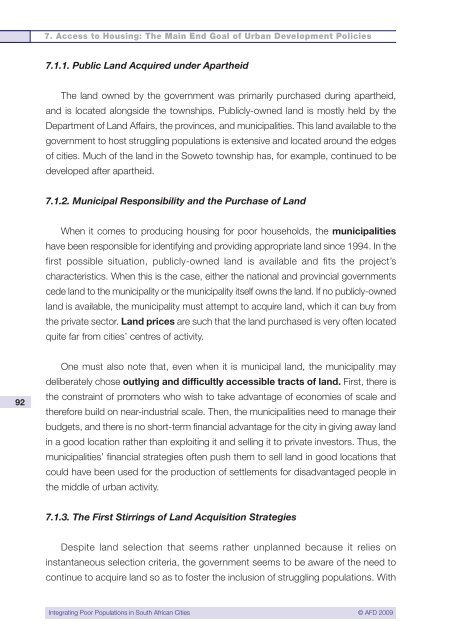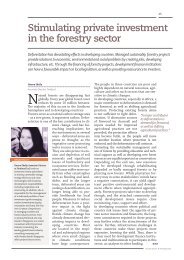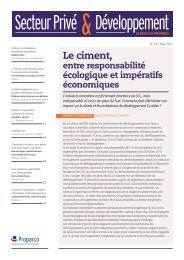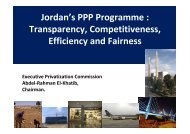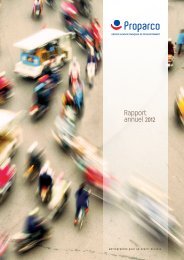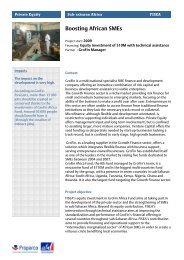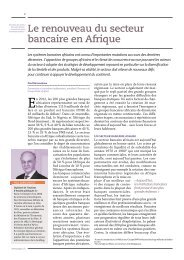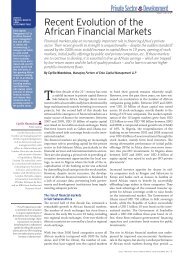Integrating Poor Populations in South African Cities - Agence ...
Integrating Poor Populations in South African Cities - Agence ...
Integrating Poor Populations in South African Cities - Agence ...
You also want an ePaper? Increase the reach of your titles
YUMPU automatically turns print PDFs into web optimized ePapers that Google loves.
7. Access to Hous<strong>in</strong>g: The Ma<strong>in</strong> End Goal of Urban Development Policies<br />
7.1.1. Public Land Acquired under Apartheid<br />
The land owned by the government was primarily purchased dur<strong>in</strong>g apartheid,<br />
and is located alongside the townships. Publicly-owned land is mostly held by the<br />
Department of Land Affairs, the prov<strong>in</strong>ces, and municipalities. This land available to the<br />
government to host struggl<strong>in</strong>g populations is extensive and located around the edges<br />
of cities. Much of the land <strong>in</strong> the Soweto township has, for example, cont<strong>in</strong>ued to be<br />
developed after apartheid.<br />
7.1.2. Municipal Responsibility and the Purchase of Land<br />
When it comes to produc<strong>in</strong>g hous<strong>in</strong>g for poor households, the municipalities<br />
have been responsible for identify<strong>in</strong>g and provid<strong>in</strong>g appropriate land s<strong>in</strong>ce 1994. In the<br />
first possible situation, publicly-owned land is available and fits the project’s<br />
characteristics. When this is the case, either the national and prov<strong>in</strong>cial governments<br />
cede land to the municipality or the municipality itself owns the land. If no publicly-owned<br />
land is available, the municipality must attempt to acquire land, which it can buy from<br />
the private sector. Land prices are such that the land purchased is very often located<br />
quite far from cities’ centres of activity.<br />
92<br />
One must also note that, even when it is municipal land, the municipality may<br />
deliberately chose outly<strong>in</strong>g and difficultly accessible tracts of land. First, there is<br />
the constra<strong>in</strong>t of promoters who wish to take advantage of economies of scale and<br />
therefore build on near-<strong>in</strong>dustrial scale. Then, the municipalities need to manage their<br />
budgets, and there is no short-term f<strong>in</strong>ancial advantage for the city <strong>in</strong> giv<strong>in</strong>g away land<br />
<strong>in</strong> a good location rather than exploit<strong>in</strong>g it and sell<strong>in</strong>g it to private <strong>in</strong>vestors. Thus, the<br />
municipalities’ f<strong>in</strong>ancial strategies often push them to sell land <strong>in</strong> good locations that<br />
could have been used for the production of settlements for disadvantaged people <strong>in</strong><br />
the middle of urban activity.<br />
7.1.3. The First Stirr<strong>in</strong>gs of Land Acquisition Strategies<br />
Despite land selection that seems rather unplanned because it relies on<br />
<strong>in</strong>stantaneous selection criteria, the government seems to be aware of the need to<br />
cont<strong>in</strong>ue to acquire land so as to foster the <strong>in</strong>clusion of struggl<strong>in</strong>g populations. With<br />
<strong>Integrat<strong>in</strong>g</strong> <strong>Poor</strong> <strong>Populations</strong> <strong>in</strong> <strong>South</strong> <strong>African</strong> <strong>Cities</strong> © AFD 2009


